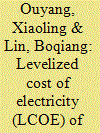|
|
|
Sort Order |
|
|
|
Items / Page
|
|
|
|
|
|
|
| Srl | Item |
| 1 |
ID:
113411


|
|
|
|
|
| Publication |
2012.
|
| Summary/Abstract |
The Japanese electricity sector is facing serious challenges in the aftermath of the Fukushima nuclear disaster. The government has responded to the crisis with a new feed-in-tariff to promote increased utilization of renewable energy, and proposed to reduce the dependence on nuclear power. In this viewpoint, we liken the transition implied by recently updated goals for the diffusion of renewables in Japan to the transition in Germany in the last decade. We argue that some of the lessons learned in Germany might prove valuable for the steps Japan considers taking. In particular, we focus on the new Japanese feed-in tariff for solar photovoltaics. In view of the recent developments in Germany, we emphasize the importance of the scheme's political legitimacy, which needs to be maintained through adequate design of both policy instrument and political process. We conclude with policy implications and a targeted research agenda.
|
|
|
|
|
|
|
|
|
|
|
|
|
|
|
|
| 2 |
ID:
132748


|
|
|
|
|
| Publication |
2014.
|
| Summary/Abstract |
The development and utilization of renewable energy (RE), a strategic choice for energy structural adjustment, is an important measure of carbon emissions reduction in China. High cost is a main restriction element for large-scale development of RE, and accurate cost estimation of renewable power generation is urgently necessary. This is the first systemic study on the levelized cost of electricity (LCOE) of RE in China. Results indicate that feed-in-tariff (FIT) of RE should be improved and dynamically adjusted based on the LCOE to provide a better support of the development of RE. The current FIT in China can only cover the LCOE of wind (onshore) and solar photovoltaic energy (PV) at a discount rate of 5%. Subsidies to renewables-based electricity generation, except biomass energy, still need to be increased at higher discount rates. Main conclusions are drawn as follows: (1) Government policy should focus on solving the financing problem of RE projects because fixed capital investment exerts considerable influence over the LCOE; and (2) the problem of high cost could be solved by providing subsidies in the short term and more importantly, by reforming electricity price in the mid-and long-term to make the RE competitive.
|
|
|
|
|
|
|
|
|
|
|
|
|
|
|
|
| 3 |
ID:
169851


|
|
|
|
|
| Summary/Abstract |
In recent years, photovoltaic (PV) solar energy has become the most growing form of renewable electricity generation in the world. Due to its vast tropical territorial area, Brazil is one of the countries with the most significant potential for PV implementation. However, by the end of 2018, the distributed generation of Brazil by PV source had only 2.4 W/inhabitant, while many countries have more than 100 W/inhabitant. In order to identify opportunities for advancing PV participation in the country, this paper proposes mathematical modeling based on 18 performance indicators capable of measuring the level of competitiveness of municipalities for the PV installation. The methodology proposes the use of the multicriteria Analytic Hierarchy Process technique. Through consultation in 100% of the 497 municipalities in the state of Brazil with higher penetration of PV per capita, it was possible to generate a ranking with the level of competitiveness for PV installations. With this, one can identify the 20 most competitive urban sectors for investment in photovoltaic installations connected to the grid. The results explain the unequal diffusion patterns in southern Brazil and propose actions to disseminate distributed generation.
|
|
|
|
|
|
|
|
|
|
|
|
|
|
|
|
| 4 |
ID:
088253


|
|
|
|
|
| Publication |
2009.
|
| Summary/Abstract |
The paper considers the role of government funded demonstration projects and field trials (DTs) in accelerating the commercialisation of new energy technologies that meet a public good but do not have immediate market appeal [Sagar, A.D., van der Zwaan, B., 2006. Technological innovation in the energy sector: R&D, deployment, and learning-by-doing. Energy Policy 34, 2601-2608]. Drawing on an original database of DTs in the EU, Japan and USA from 1973 to 2004, we review the history of DTs in photovoltaic technology for electricity generation, and its subsequent take up as a commercial energy source.
We find that DTs that are aimed purely at discovering suitable market opportunities are less successful in achieving diffusion than projects that target a particular application and concentrate resources on it. The former nevertheless have a vital role to play in the learning process, while a targeted focus is often dependent on national industrial and institutional factors.
|
|
|
|
|
|
|
|
|
|
|
|
|
|
|
|
| 5 |
ID:
183567


|
|
|
|
|
| Summary/Abstract |
Prior research on adoption of rooftop solar has investigated various economic and psychological factors contributing to or impeding adoption. One psychological factor that has been linked to environmental behavior in other settings, but not yet in the context of rooftop solar, is place attachment, an individual's sense of attachment to their community. Using a survey of over 3700 homeowners in Los Angeles County, we examine the impact of place attachment, relative to that of pro-environmental attitudes, on the decision whether to consider rooftop solar and on the decision whether to adopt it. We find that an otherwise average homeowner with pro-environmental attitudes one unit above the mean is 5.66 percentage points more likely to consider rooftop solar, while the effect of place attachment on consideration is not significant. However, among respondents who consider rooftop solar, an otherwise average homeowner with one unit stronger place attachment is 7.59 percentage points more likely to adopt, while the effect of pro-environmental attitudes on adoption is not significant. Policymakers seeking to encourage adoption of rooftop solar should contemplate leveraging place attachment, and should recognize that different policy mechanisms will be effective for homeowners in general than for those who are already considering.
|
|
|
|
|
|
|
|
|
|
|
|
|
|
|
|
| 6 |
ID:
125873


|
|
|
|
|
| Publication |
2013.
|
| Summary/Abstract |
For alternative energy technologies like photovoltaics (PV), the analysis of Research and Development (R&D) expenses is important to observe and understand market dynamics. This is, in turn, essential for policymakers. However, the quantitative evaluation of global corporate R&D investments is a challenging task due to unavailability or high scatter of precise data. Here we present a top-down approach to estimate the current and global historic cumulated PV R&D investments based on international PV patent applications. High growth rates of PV-related patents and R&D headcount accompany growth and development of the PV market and are an excellent indicator to analyze R&D investments. With this approach, current annual corporate PV R&D investments are found to be about 6000 m€ and show a rapidly increasing trend on a global scale.
|
|
|
|
|
|
|
|
|
|
|
|
|
|
|
|
| 7 |
ID:
166450


|
|
|
|
|
| Summary/Abstract |
Distributed energy resources, such as rooftop solar photovoltaics (PV), are likely to comprise a substantial fraction of new generation capacity in the United States. However, forecasting technology adoption based on people's willingness to pay (WTP) faces two major challenges: the stated-intention and omitted-variable biases. Previous solar adoption literature has neglected to address these two biases altogether. Here, we adopt a “parameterization + calibration” approach to address both biases and estimate customers’ WTP for PV. After collecting survey data on respondents’ WTP for adopting PV, we characterize its empirical cumulative density function using a gamma distribution. We further calibrate the gamma distribution parameters using a national distributed PV adoption simulation model, finding the parameters that produce the best fit between simulated and historic solar adoption. We then show that the calibrated gamma distribution improves the raw WTP data after correcting for the two biases. Finally, we use our optimally-calibrated WTP to forecast market demand for residential PV at the county-level of the United States in 2020. Improving estimates of customer willingness to pay has significant implications for policy directly, e.g. estimating the effect of a proposed policy on technology adoption, and other regulatory processes that use forecasting, e.g. integrated resource planning.
|
|
|
|
|
|
|
|
|
|
|
|
|
|
|
|
| 8 |
ID:
186413


|
|
|
|
|
| Summary/Abstract |
Auctions for renewable energy support allocation are on a triumphant global advance. We compare performance of renewable energy auctions in terms of effectiveness (realisation rate and period) and efficiency (price outcomes) from two world regions: South Africa and European countries (Germany, France, the Netherlands). We develop an assessment framework for compliance incentivisation in auction design, covering qualification criteria, penalties, and compliance monitoring. We find that a 100% realisation rate in South Africa is connected to a strong compliance package, while European countries have moderate realisation rates (23%–87%) with relatively lenient compliance packages. We observe that realisation periods are correlated with project size rather than granted realisation period. Although South African projects generally have longer realisation periods (34 months for PV and 40 months for onshore wind) than European projects (16.5–30 months for PV and 19–25 months for onshore wind), they perform comparably considering that they are 10–13 times larger. Comparing average auction prices with equivalent technology-specific LCOE estimates, we find a general convergence towards the global average, with South Africa having the sharpest price decline (75% PV and 54% onshore wind), albeit starting from the highest level. Our findings, especially on importance of compliance incentivisation and weak impact of granted realisation periods, are valid across world regions and can support policymakers everywhere in designing effective and efficient renewable energy auctions.
|
|
|
|
|
|
|
|
|
|
|
|
|
|
|
|
|
|
|
|
|